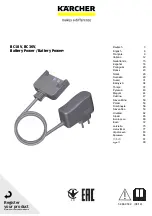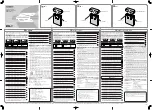
IMPORTANT:
To reduce the risk of a battery explosion, follow these instructions and those published by the battery manufacturer and the
manufacturer of any equipment you intend to use in the vicinity of the battery. Remember to review warning marks on all products and on
engines.
1.1.
PERSONAL PRECAUTIONS
Ensure there is another person within hearing range, or close enough to come to your aid should a problem arise, when working near
a lead-acid battery.
Have fresh water and soap nearby in case battery acid contacts skin, clothing or eyes.
Wear safety eye protection and protective clothing. Avoid touching eyes while working with a battery.
Wash immediately with soap and water if battery acid contacts skin or clothing. If acid enters eye, flush eye immediately with cool, clean
running water for at least 15 minutes and seek immediate medical attention.
Remove personal metallic items such as rings, bracelets, necklaces and watches. A battery can produce a short-circuit current high enough
to weld a ring or the like to metal, which may cause severe burns.
1.2.
IMPORTANT SAFETY INSTRUCTIONS
Familiarise yourself with the applications, limitations and potential hazards of the RoadStart.
Keep the unit in good working order and condition. Replace damaged parts immediately.
Use only recommended parts. To use unapproved parts may be dangerous and will invalidate your warranty.
The RoadStart must only be opened and checked by qualified service personnel.
DO NOT
disassemble the unit for any reason.
Keep children and unauthorised persons away from the work area.
This RoadStart is not intended for use by persons (including children) with reduced physiclal, sensory or mental capabilities, or lack of
experience and knowledge, unless they have been given supervision or instruction concerning the use of the appliance by a person
responsible for their safety.
Keep work area clean and tidy and free from unrelated materials. Ensure that there is adequate lighting.
If the RoadStart receives a sharp knock or blow, it must be checked by a qualified service agent before being used.
When not in use re-charge every 30 days or sooner.
DO NOT
touch positive and negative clamps together as this could cause an explosion.
DO NOT
smoke or allow a spark, or flame in the vicinity of the battery or engine.
DO NOT
drop any metal item onto the battery as it may spark or short circuit the battery, which could cause an explosion.
DO NOT
use RoadStart to recharge dry cell batteries that are commonly used with home appliances. These batteries may explode and
cause personal injury and damage to property.
DO NOT
charge or boost a frozen battery.
DO NOT
use attachments other than those recommended. To do so may cause damage to the unit and other equipment and possible
personal injury.
DO NOT
pull or carry the unit by its cables and do not pull the negative and positive clamps from the battery terminals.
DO NOT
operate in vicinity of flammable liquids or gases.
DO NOT
recharge the unit with plugs, cables or attachments that are damaged. Replace such items immediately.
DO NOT
use this RoadStart to perform a task for which it is not designed.
DO NOT
store the unit in damp or wet locations or where the temperature may exceed 50°C.
DO NOT
submerge the unit in water.
DO NOT
use whilst under the influence of drugs, alcohol or intoxicating medication.
DO NOT
leave the unit in a totally discharged state for an extended period of time as this may result in permanent damage to the battery.
DO NOT
cross-connect the power leads from the RoadStart to the battery. Ensure that positive is to positive and negative is to negative.
Ensure that the unit is fully charged before storage.
1.3.
ELECTRICAL SAFETY (with respect to mains chargers)
WARNING!
It is the user’s responsibility to check the following:
You must
check the AC adaptor to ensure that it is safe before using.
You must
inspect the power supply lead, plugs and all
electrical connections for wear and damage.
You must
ensure the risk of electric shock is minimised by the installation of appropriate
safety devices. An RCCB (Residual Current Circuit Breaker) should be incorporated in the main distribution board. We recommend
that an RCD (Residual Current Device) is used with all electrical products. It is particularly important to use an RCD with portable
products that plug into an electrical supply not protected by an RCCB. If in doubt consult a qualified electrician. You can
1. SAFETY
Original Language Version
PBI2212S,PBI3612S,PBI3624S,PBI4424S Issue: 1 - 06/05/14
INSTRUCTIONS FOR:
ROADSTART® EMERGENCY POWER PACKS
DEKRA APPROVED
PART No's:
PBI2212S, PBI3612S, PBI3624S, PBI4424S
IMPORTANT:
PLEASE READ THESE INSTRUCTIONS CAREFULLY. NOTE THE SAFE OPERATIONAL REQUIREMENTS, WARNINGS & CAUTIONS. USE THE
PRODUCT CORRECTLY AND WITH CARE FOR THE PURPOSE FOR WHICH IT IS INTENDED. FAILURE TO DO SO MAY CAUSE DAMAGE AND/OR
PERSONAL INJURY AND WILL INVALIDATE THE WARRANTY. KEEP THESE INSTRUCTIONS SAFE FOR FUTURE USE.
Thank you for purchasing a Sealey product. Manufactured to a high standard, this product will, if used according to these
instructions, and properly maintained, give you years of trouble free performance.
Safety Markings/Symbols
Read
Instructions
Before Use
Fuse-
section 6.2
refers
Keep Dry
Use in Well
Ventilated
Area
Keep away from
Ignition Sources;
Danger of Explosive
Gases
© Jack Sealey Ltd























